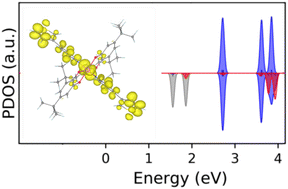Electronic structure of cobalt valence tautomeric molecules in different environments†
Abstract
Future molecular microelectronics require the electronic conductivity of the device to be tunable without impairing the voltage control of the molecular electronic properties. This work reports the influence of an interface between a semiconducting polyaniline polymer or a polar poly-D-lysine molecular film and one of two valence tautomeric complexes, i.e., [CoIII(SQ)(Cat)(4-CN-py)2] ↔ [CoII(SQ)2(4-CN-py)2] and [CoIII(SQ)(Cat)(3-tpp)2] ↔ [CoII(SQ)2(3-tpp)2]. The electronic transitions and orbitals are identified using X-ray photoemission, X-ray absorption, inverse photoemission, and optical absorption spectroscopy measurements that are guided by density functional theory. Except for slightly modified binding energies and shifted orbital levels, the choice of the underlying substrate layer has little effect on the electronic structure. A prominent unoccupied ligand-to-metal charge transfer state exists in [CoIII(SQ)(Cat)(3-tpp)2] ↔ [CoII(SQ)2(3-tpp)2] that is virtually insensitive to the interface between the polymer and tautomeric complexes in the CoII high-spin state.

- This article is part of the themed collection: Nanoscale 2023 Emerging Investigators


 Please wait while we load your content...
Please wait while we load your content...